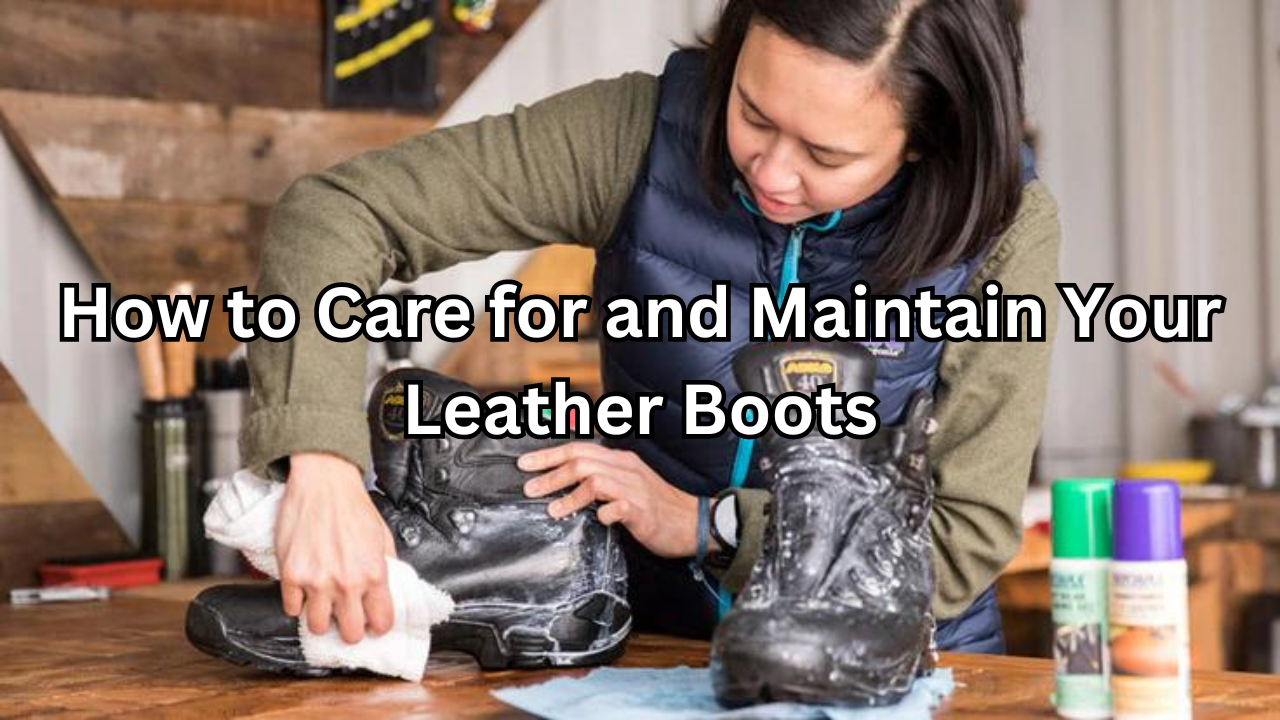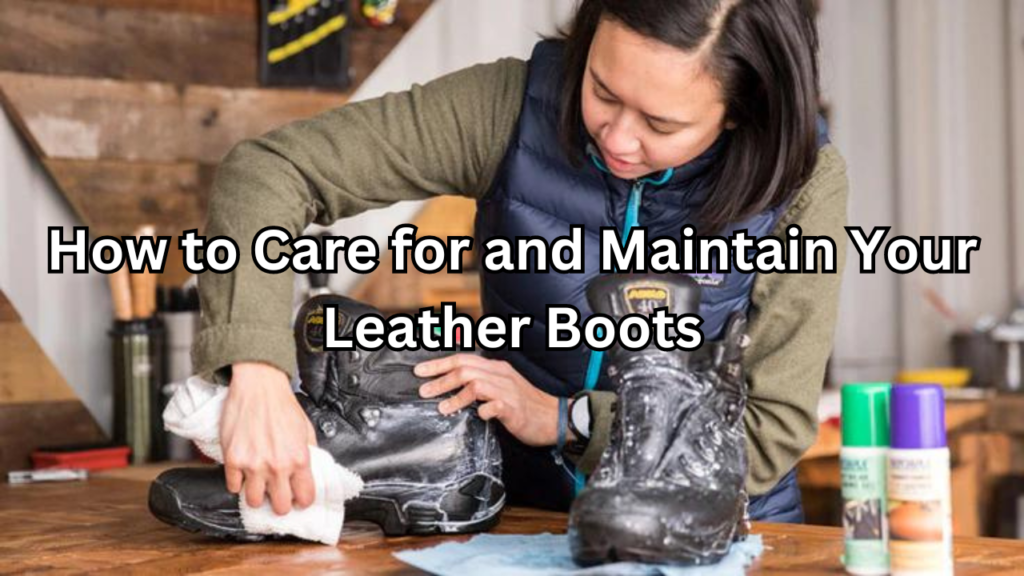

Table of Contents
Introduction
Leather boots are more than just a fashion statement—they are a timeless investment in both style and function. Whether you’re wearing them for work, casual outings, or outdoor adventures, leather boots offer unparalleled durability and elegance. However, to fully reap the benefits of this classic footwear, proper care and maintenance are essential. In this article, we’ll explore why it’s crucial to care for your leather boots and the many advantages of keeping them in top condition.
Importance of Proper Care for Leather Boots
Leather is a natural material that, while robust, requires regular attention to maintain its integrity and appearance. Proper care helps prevent common issues such as cracking, discoloration, and water damage. Without regular maintenance, leather can become dry and brittle, leading to irreversible damage.
One of the most important aspects of leather care is cleaning. Dust, dirt, and grime can accumulate on the surface and penetrate the leather, causing it to deteriorate. Regular cleaning not only keeps your boots looking their best but also helps prevent these particles from causing long-term damage. Additionally, conditioning the leather helps maintain its natural oils, keeping it soft and supple.
Benefits of Maintaining Leather Boots
Longevity: Regular care significantly extends the life of your fashion leather boots. By addressing minor issues before they become major problems, you prevent premature wear and tear. Proper cleaning, conditioning, and waterproofing protect the leather from environmental factors that can cause damage, ensuring your boots remain in good condition for years.
Appearance: Well-maintained leather boots always look their best. Regular polishing and conditioning restore the leather’s natural luster and prevent it from looking dull or worn. A polished pair of boots can enhance your overall appearance, adding a touch of sophistication to any outfit.
Comfort: Leather boots that are properly cared for are not only more attractive but also more comfortable. When leather is conditioned and kept supple, it molds to the shape of your feet more comfortably. This prevents discomfort and potential foot problems that can arise from stiff or cracked leather. Additionally, maintaining the structural integrity of your boots helps ensure that they continue to support your feet properly.
In summary, investing time in the proper care and maintenance of your leather boots pays off in numerous ways. From prolonging their lifespan to keeping them looking sharp and feeling comfortable, these practices are essential for anyone who values quality footgear.
Understanding Leather Types
Leather is a versatile material that comes in various types, each with unique characteristics and care requirements. Understanding the different types of leather can help you provide the most appropriate maintenance for your boots, ensuring their longevity and optimal appearance. Here’s a breakdown of the main types of leather and their specific care needs.
Different Types of Leather
Full-Grain Leather:
Full-grain leather is the highest quality women leather available. It is made from the top layer of the hide and retains the natural grain, which makes it more durable and resistant to wear and tear. This type of leather develops a rich patina over time, adding to its character and beauty.
Top-Grain Leather:
Top-grain leather is also derived from the top layer of the hide but is sanded and refinished to remove imperfections. This process makes it slightly less durable than full-grain leather but still offers a high level of quality and is often more affordable. It has a smoother surface and is less prone to developing a patina.
Nubuck Leather:
Nubuck leather is similar to full-grain leather but has been sanded or buffed on the grain side to create a velvety texture. This process gives nubuck its distinctive softness and a rich, suede-like feel. It is more susceptible to staining and requires extra care to maintain its appearance.
Suede Leather:
Suede is made from the inner part of the hide and has a soft, napped finish. Unlike full-grain and top-grain leather, suede is not as durable and is more prone to water damage and staining. Its delicate texture requires gentle care to keep it looking its best.
Specific Care Needs for Each Type of Leather
Full-Grain Leather:
- Cleaning: Use a soft-bristle brush or a damp cloth to remove dirt. Avoid soaking the leather.
- Conditioning: Apply a high-quality leather conditioner to keep it supple and prevent drying out. Full-grain leather benefits from regular conditioning to maintain its natural oils.
- Polishing: Use a leather polish to enhance its natural shine and protect against scuffs and scratches.
- Waterproofing: Apply a waterproofing spray to protect against moisture, especially if the boots are exposed to wet conditions.
Top-Grain Leather:
- Cleaning: Similar to full-grain leather, use a damp cloth or brush to clean. Top-grain leather may be cleaned with a mild soap solution if needed.
- Conditioning: Regular conditioning is important to keep the leather from drying out and to maintain its smooth surface.
- Polishing: A leather polish suitable for top-grain leather can help maintain its appearance and add a protective layer.
- Waterproofing: Waterproofing sprays can help protect against water damage, but be sure to use products recommended for top-grain leather.
Nubuck Leather:
- Cleaning: Use a nubuck brush or a suede eraser to gently remove dirt and stains. Avoid using water, as it can damage the texture.
- Conditioning: Nubuck leather requires a specific nubuck conditioner to maintain its texture and prevent drying out.
- Polishing: Nubuck does not typically require polishing. Instead, use a nubuck spray to protect against stains and moisture.
- Waterproofing: Apply a nubuck or suede waterproofing spray to protect against water and stains. Regular application is recommended.
Suede Leather:
- Cleaning: Use a suede brush to gently lift dirt and restore the nap. For stubborn stains, use a suede eraser or cleaner specifically designed for suede.
- Conditioning: Suede generally does not require conditioning, but applying a suede-specific protectant can help repel stains and moisture.
- Polishing: Avoid polishing suede. Instead, use a suede protectant to maintain its appearance.
- Waterproofing: Apply a suede waterproofing spray to protect against water damage and stains. Reapply regularly, especially if exposed to wet conditions.
By understanding the different types of leather and their specific care needs, you can ensure that your boots are maintained properly, keeping them looking great and extending their lifespan.
Daily Care Routine
Maintaining a daily care routine for your leather boots is key to keeping them in top condition. Simple yet effective habits can significantly extend the life of your boots and preserve their appearance. Here’s a guide to incorporating daily care into your routine.
Wiping Down Boots After Each Wear
After each wear, it’s important to give your leather boots a quick wipe-down to remove any surface dirt and moisture. This helps prevent buildup that can lead to more serious damage over time.
Steps to Wipe Down Your Boots:
Remove Dirt and Debris: Use a soft cloth or a dry, soft-bristle brush to gently remove any loose dirt or debris from the surface of the boots. Pay special attention to crevices and stitching where dirt can accumulate.
Dampen the Cloth: If needed, slightly dampen the cloth with water. Avoid soaking it, as excess moisture can damage leather.
Wipe the Boots: Gently wipe the entire surface of the boots with the damp cloth. This helps remove any residual dirt and helps prevent it from penetrating the leather.
Dry the Boots: After wiping, use a dry cloth to remove any remaining moisture. Allow the boots to air dry completely before storing them. Avoid placing them near direct heat sources, as this can cause the leather to dry out and crack.
Storing Boots Properly to Maintain Shape and Prevent Damage
Proper storage is essential to maintaining the shape and overall condition of your leather boots. The way you store your boots can prevent deformities and damage, ensuring they look and feel great for years.
Tips for Storing Your Boots:
Use Boot Trees: Insert boot trees into your boots to help them maintain their shape. Boot trees prevent the leather from creasing and help preserve the original form of the boot. If boot trees aren’t available, you can stuff the boots with acid-free tissue paper or newspaper to achieve a similar effect.
Store in a Cool, Dry Place: Keep your boots in a cool, dry environment away from direct sunlight and heat sources. Excessive heat and light can cause the leather to dry out, fade, and lose its natural oils.
Keep Away from Moisture: Ensure your storage area is dry to prevent mold and mildew growth. If your boots have been exposed to moisture, allow them to dry thoroughly before storing them.
Use Dust Bags: If possible, store your boots in dust bags or shoe covers to protect them from dust, scratches, and other potential damage. This also helps keep them clean and ready to wear.
Avoid Overstuffing: If you use paper to help maintain the shape, avoid overstuffing the boots, as this can distort their shape and create unwanted creases.
Incorporating these daily care habits into your routine ensures that your leather boots remain in excellent condition. By wiping them down after each wear and storing them properly, you can enjoy their beauty and functionality for many years.
Cleaning Leather Boots
Keeping your leather boots clean is essential for maintaining their appearance and longevity. Regular cleaning removes dirt and debris that can cause damage and helps preserve the leather’s natural luster. Here’s a comprehensive guide to cleaning your leather boots effectively.
Tools and Materials Needed
Soft Brush: A soft-bristle brush is used to gently remove loose dirt and debris from the surface of the leather. Avoid hard brushes that can scratch the leather.
Damp Cloth: A clean, soft cloth slightly dampened with water is used to wipe down the boots and remove surface dirt. Make sure the cloth is not too wet to prevent over-saturating the leather.
Leather Cleaner: A high-quality leather cleaner specifically designed for your type of leather will help remove ingrained dirt and stains. Always choose a cleaner that is appropriate for your leather type.
Step-by-Step Cleaning Process
Removing Dirt and Debris
- Prepare Your Workspace: Find a clean, flat surface to work on. Lay down a cloth or towel to catch any dirt or debris that falls off.
- Remove Laces: Take out the laces to ensure you can clean all parts of the boots effectively. Set them aside to clean separately if necessary.
- Brush Off Dirt: Use the soft-bristle brush to gently brush off any loose dirt and debris from the surface of the boots. Focus on areas where dirt tends to accumulate, such as the seams and the creases.
Using Leather Cleaner
- Apply Cleaner: Follow the instructions on your leather cleaner. Typically, you’ll need to apply a small amount of cleaner to a clean, soft cloth or sponge. Avoid using too much cleaner to prevent excess residue.
- Clean the Boots: Gently rub the cleaner into the leather using circular motions. Start from the top of the boot and work your way down, ensuring even coverage. Pay attention to areas with stubborn stains or accumulated dirt.
- Wipe Off Residue: After applying the cleaner, use a damp cloth to wipe away any excess cleaner and dirt. Ensure that you do not oversaturate the leather with water.
Drying Boots Properly
- Pat Dry: Use a clean, dry cloth to pat the boots and remove any remaining moisture. Avoid rubbing too hard, as this can damage the leather.
- Air Dry: Allow the boots to air dry completely at room temperature. Avoid placing them near direct heat sources like radiators or hair dryers, as excessive heat can cause the leather to dry out and become brittle.
- Maintain Shape: While drying, place boot trees or stuff the boots with paper to help them maintain their shape and prevent creasing. This also helps absorb any remaining moisture inside the boots.
By following these steps, you’ll ensure that your leather boots remain clean and well-maintained, preserving their appearance and extending their lifespan. Regular cleaning is a simple but crucial part of leather boot care that keeps them looking their best and functioning well.
Conditioning Leather Boots
Conditioning is a vital part of leather boot care that helps keep the leather supple, moisturized, and protected from damage. Proper conditioning prevents the leather from drying out and cracking, ensuring that your boots remain in excellent condition. Here’s how to effectively condition your leather boots.
Importance of Conditioning
Conditioning leather boots is crucial for several reasons:
- Preventing Drying and Cracking: Leather is a natural material that can lose its oils and moisture over time, especially with regular use and exposure to environmental elements. Conditioning replenishes these essential oils, preventing the leather from becoming dry and brittle. This helps maintain the leather’s flexibility and prevents unsightly cracks and creases.
- Enhancing Durability: Properly conditioned leather is more resistant to wear and tear. It helps preserve the integrity of the leather, making it more resilient against everyday use and environmental stressors.
- Improving Appearance: Conditioning brings out the leather’s natural shine and richness. It helps restore and maintain the leather’s color and texture, giving your boots a fresh, polished look.
Choosing the Right Conditioner for Your Leather Type
Selecting the appropriate conditioner is essential for achieving the best results:
- Full-Grain and Top-Grain Leather: Use a high-quality leather conditioner specifically designed for full-grain or top-grain leather. These conditioners are typically formulated to be more nourishing and can handle the natural oils of these leathers.
- Nubuck Leather: For nubuck leather, choose a conditioner that is designed for nubuck or suede. These conditioners are usually lighter and won’t alter the unique texture of nubuck leather.
- Suede Leather: Suede requires specialized conditioners that are often in spray form. These products are formulated to protect and maintain suede’s delicate nap without causing it to flatten or lose its texture.
How to Apply Conditioner Properly
Clean the Boots First: Before conditioning, ensure your boots are clean and completely dry. Remove any dirt and debris using a soft brush and a damp cloth, and allow the boots to air dry.
Test the Conditioner: Always test the conditioner on a small, inconspicuous area of the leather first. This ensures that the product does not alter the color or texture of the leather.
Apply Conditioner:
- For Cream Conditioners: Use a clean, soft cloth or applicator brush to apply a small amount of conditioner to the leather. Rub the conditioner in using circular motions, covering the entire surface evenly. Be sure to apply it in thin layers rather than a heavy coat to avoid excess buildup.
- For Liquid Conditioners: If using a liquid conditioner, follow the instructions on the product. Generally, you will apply it using a clean cloth or sponge. Apply a small amount of liquid and spread it evenly over the leather.
Allow to Absorb: Let the conditioner absorb into the leather for the recommended time, usually a few hours or overnight. This allows the leather to fully soak in the nourishing oils.
Buff the Boots: After the conditioner has absorbed, use a soft, dry cloth to buff the boots. This helps remove any excess conditioner and enhances the leather’s natural shine.
Re-lace: Once the boots are fully conditioned and dry, re-lace them and store them properly to maintain their shape.
By incorporating regular conditioning into your leather boot care routine, you’ll keep your boots looking great and feeling comfortable. Proper conditioning not only extends the life of your leather but also enhances its natural beauty and resilience.
Conditioning Leather Boots
Conditioning is a vital part of leather boot care that helps keep the leather supple, moisturized, and protected from damage. Proper conditioning prevents the leather from drying out and cracking, ensuring that your boots remain in excellent condition. Here’s how to effectively condition your leather boots.
Importance of Conditioning
Conditioning leather boots is crucial for several reasons:
- Preventing Drying and Cracking: Leather is a natural material that can lose its oils and moisture over time, especially with regular use and exposure to environmental elements. Conditioning replenishes these essential oils, preventing the leather from becoming dry and brittle. This helps maintain the leather’s flexibility and prevents unsightly cracks and creases.
- Enhancing Durability: Properly conditioned leather is more resistant to wear and tear. It helps preserve the integrity of the leather, making it more resilient against everyday use and environmental stressors.
- Improving Appearance: Conditioning brings out the leather’s natural shine and richness. It helps restore and maintain the leather’s color and texture, giving your boots a fresh, polished look.
Choosing the Right Conditioner for Your Leather Type
Selecting the appropriate conditioner is essential for achieving the best results:
- Full-Grain and Top-Grain Leather: Use a high-quality leather conditioner specifically designed for full-grain or top-grain leather. These conditioners are typically formulated to be more nourishing and can handle the natural oils of these leathers.
- Nubuck Leather: For nubuck leather, choose a conditioner that is designed for nubuck or suede. These conditioners are usually lighter and won’t alter the unique texture of nubuck leather.
- Suede Leather: Suede requires specialized conditioners that are often in spray form. These products are formulated to protect and maintain suede’s delicate nap without causing it to flatten or lose its texture.
How to Apply Conditioner Properly
Clean the Boots First: Before conditioning, ensure your boots are clean and completely dry. Remove any dirt and debris using a soft brush and a damp cloth, and allow the boots to air dry.
Test the Conditioner: Always test the conditioner on a small, inconspicuous area of the leather first. This ensures that the product does not alter the color or texture of the leather.
Apply Conditioner:
- For Cream Conditioners: Use a clean, soft cloth or applicator brush to apply a small amount of conditioner to the leather. Rub the conditioner in using circular motions, covering the entire surface evenly. Be sure to apply it in thin layers rather than a heavy coat to avoid excess buildup.
- For Liquid Conditioners: If using a liquid conditioner, follow the instructions on the product. Generally, you will apply it using a clean cloth or sponge. Apply a small amount of liquid and spread it evenly over the leather.
Allow to Absorb: Let the conditioner absorb into the leather for the recommended time, usually a few hours or overnight. This allows the leather to fully soak in the nourishing oils.
Buff the Boots: After the conditioner has absorbed, use a soft, dry cloth to buff the boots. This helps remove any excess conditioner and enhances the leather’s natural shine.
Re-lace: Once the boots are fully conditioned and dry, re-lace them and store them properly to maintain their shape.
By incorporating regular conditioning into your leather boot care routine, you’ll keep your boots looking great and feeling comfortable. Proper conditioning not only extends the life of your leather but also enhances its natural beauty and resilience.
Waterproofing Leather Boots
Proper waterproofing is crucial for maintaining the condition of leather boots, especially if they are frequently exposed to wet or muddy environments. Waterproofing helps protect the leather from moisture and stains, ensuring that your boots remain functional and visually appealing. Here’s a guide to effectively waterproofing your leather boots.
Importance of Waterproofing
Protecting Against Moisture and Stains: Leather is naturally porous, which makes it susceptible to water damage and staining. When leather absorbs moisture, it can become discolored, lose its shape, and develop mold or mildew. Waterproofing creates a protective barrier on the surface of the leather, repelling water and reducing the likelihood of stains. This not only preserves the appearance of your boots but also helps maintain their structural integrity.
Types of Waterproofing Products
Sprays:
- Overview: Waterproofing sprays are a popular and easy-to-use option. They form a protective layer over the leather that repels water and prevents stains.
- Best For: Ideal for all types of leather, including full-grain, top-grain, nubuck, and suede.
- Application: Simply spray an even layer over the clean, dry boots, and allow it to dry as per the product instructions.
Waxes:
- Overview: Waxes provide a durable waterproof layer that also conditions the leather. They are generally thicker and offer a more substantial protection.
- Best For: Suitable for full-grain and top-grain leather boots. Waxes can sometimes darken lighter leathers.
- Application: Apply the wax with a clean cloth or applicator brush, working it into the leather in circular motions. Allow it to dry, then buff the boots with a dry cloth.
Creams:
- Overview: Waterproofing creams are similar to conditioners but with added water-repellent properties. They nourish the leather while providing a protective barrier.
- Best For: Ideal for full-grain and top-grain leather, and some can be used on nubuck.
- Application: Apply the cream with a clean cloth, spreading it evenly over the leather. Allow it to absorb and dry, then buff with a soft cloth.
Application Techniques for Effective Waterproofing
Clean the Boots: Ensure the boots are clean and dry before applying any waterproofing product. Dirt and moisture can interfere with the effectiveness of the product.
Test the Product: Always test the waterproofing product on a small, inconspicuous area of the boot to ensure it does not alter the color or texture of the leather.
Apply Evenly: Use the appropriate applicator (spray bottle, cloth, or brush) to apply the waterproofing product evenly across the surface of the boots. Avoid over-application to prevent product buildup.
Allow to Dry: Follow the product’s instructions for drying time. Ensure the boots are allowed to dry completely in a well-ventilated area, away from direct heat sources.
Buff the Boots: Once dry, use a soft, dry cloth to buff the boots. This helps remove any excess product and enhances the leather’s natural shine.
Dealing with Scuffs and Scratches
Leather boots can experience scuffs and scratches from regular use. Addressing these issues promptly can help maintain their appearance and extend their lifespan.
Assessing the Damage
Surface Scuffs:
- Overview: Surface scuffs are minor abrasions that affect only the top layer of the leather. They are usually shallow and can often be treated with basic leather care products.
Deep Scratches:
- Overview: Deep scratches penetrate beyond the surface, affecting the leather’s structure. These are more serious and may require more intensive repair methods.
Methods for Minor Repairs
Using a Leather Balm:
- Surface Scuffs: Apply a small amount of leather balm to the scuffed area. Use a soft cloth or applicator to gently rub the balm into the leather in circular motions. This can help reduce the appearance of scuffs and restore the leather’s natural finish.
Using a Polish:
- Surface Scuffs: For additional shine and protection, apply a matching leather polish. Use a clean cloth to apply the polish, following the manufacturer’s instructions. Buff the area to blend the polish and improve the leather’s overall appearance.
When to Seek Professional Repair Services
Extensive Damage: If your boots have deep scratches, large scuffs, or other significant damage, it may be best to consult a professional cobbler or leather repair specialist. They have the tools and expertise to perform more complex repairs, including leather reconditioning, color matching, and structural repairs.
Restoration Needs: For boots that require extensive restoration or have sentimental value, professional repair services can provide high-quality results that preserve the integrity and appearance of the leather.
By following these guidelines for waterproofing and repairing your leather boots, you can ensure they remain in excellent condition, providing you with both style and function for years to come.
Storing Leather Boots
Proper storage of leather boots is essential for maintaining their shape, appearance, and overall longevity. How you store your boots can prevent damage and ensure they remain in excellent condition for years to come.
Best Practices for Storing
Cool, Dry Place: Store your leather boots in a cool, dry environment to prevent moisture-related damage. Excessive humidity can lead to mold growth and weaken the leather, while heat can cause the leather to dry out and crack.
Avoid Direct Sunlight: Keep your boots away from direct sunlight. Prolonged exposure to UV rays can cause the leather to fade and dry out, affecting both its color and texture.
Using Boot Trees to Maintain Shape
Purpose of Boot Trees: Boot trees are essential for maintaining the shape of your leather boots. They help prevent creasing, collapsing, and distortion, especially in the toe and arch areas.
Types of Boot Trees: Choose boot trees that are adjustable and made from materials that absorb moisture, such as cedar. Cedar boot trees not only help maintain shape but also help absorb any residual moisture from the inside of the boots.
Insertion and Removal: Insert the boot trees carefully into your boots after each wear or when storing them for extended periods. Remove them gently to avoid damaging the leather.
Tips for Seasonal Storage
Cleaning Before Storage: Before storing your boots for the season, ensure they are clean. Remove any dirt and debris with a soft brush and a damp cloth, and allow them to dry completely.
Conditioning Before Storage: Apply a conditioning product to the leather to replenish its natural oils and prevent it from drying out. This helps maintain the leather’s flexibility and prevents it from becoming brittle during storage.
Seasonal Storage Bags: For Seasonal boot, consider storing your boots in breathable fabric dust bags or shoe covers. This helps keep them clean and protected from dust and scratches.
Seasonal Care Tips
Adjusting your care routine based on weather conditions helps ensure your leather boots remain in optimal condition throughout the year.
Adjusting Care Routine Based on Weather Conditions
Winter:
- Protecting from Salt and Snow: In winter, salt and snow can damage leather. Apply a waterproofing spray to protect your boots from moisture. After exposure to salt, clean the boots promptly with a damp cloth to remove any residue and prevent salt stains. Use a leather conditioner to keep the leather supple after cleaning.
- Drying Boots: If your boots get wet, allow them to air dry completely at room temperature. Stuff them with newspaper or boot trees to help them retain their shape and absorb moisture. Avoid drying them near direct heat sources.
Summer:
- Handling Heat and Humidity: In hot and humid conditions, leather can become dry and stiff. Ensure your boots are stored in a cool, dry place to prevent excessive moisture buildup. Regularly condition your boots to keep the leather supple and prevent cracking.
- Breathability: Allow your boots to breathe by storing them in a well-ventilated area. If your boots become sweaty or damp, clean and dry them promptly to prevent odor and mold.
By following these storage and seasonal care tips, you can keep your leather boots looking and performing their best throughout the year. Proper storage and routine maintenance are key to ensuring your investment in leather boots pays off with lasting style and durability.
Conclusion
In conclusion, proper care and maintenance are essential for ensuring the longevity and beauty of your leather boots. By adhering to a consistent care routine, you can keep your boots looking great and performing well for years to come. Here’s a recap of the key points discussed:
First, understanding the different types of leather—such as full-grain, top-grain, nubuck, and suede—allows you to select the appropriate products and techniques for cleaning, conditioning, and waterproofing. Each type of leather has unique care requirements, and using the right products helps preserve its specific qualities.
Daily care routines, including wiping down your boots after each wear and storing them properly, are crucial for maintaining their shape and preventing damage. Proper storage in a cool, dry place, along with the use of boot trees, helps keep your boots in optimal condition. Seasonal care tips, such as protecting against winter boots and snow or handling summer humidity, ensure that your boots are well-protected throughout the year.
When it comes to cleaning and conditioning, regularly removing dirt, using the right cleaning products, and applying conditioners tailored to your leather type are vital steps in preserving the leather’s appearance and flexibility. Waterproofing is equally important, as it protects your boots from moisture and stains, enhancing their durability.
In summary, following a comprehensive care routine not only extends the lifespan of your leather boots but also maintains their aesthetic appeal. Invest time in caring for your boots, and they will reward you with continued comfort and style.
Final Tips: Always address minor issues like scuffs and scratches promptly to prevent further damage. Regularly inspect your boots for signs of wear and treat them as needed. With these practices, your leather boots will remain a cherished part of your wardrobe, offering both functionality and elegance for many years.






